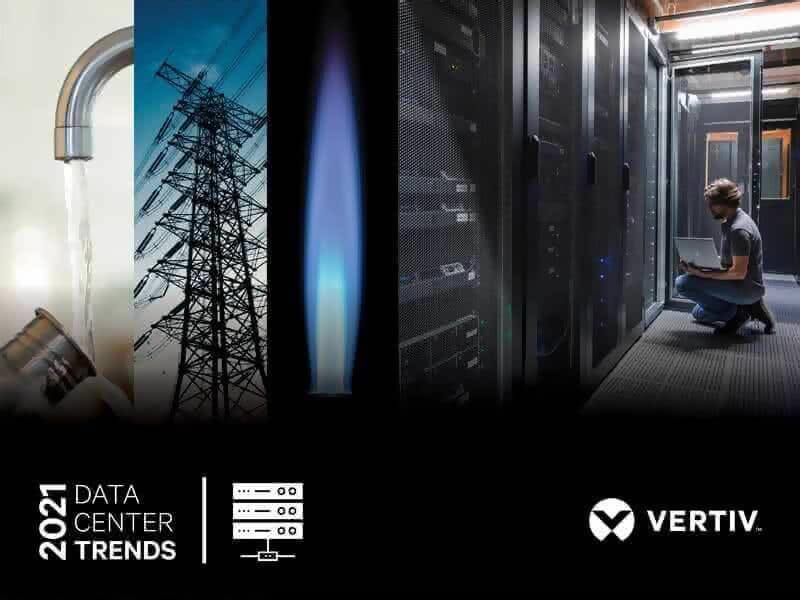Embracing best practices, partnering with customers to amplify efficiency will be key for operators
Columbus, Ohio [Feb. 23, 2021] – 5G will be the most transformative communications technology in a generation and enable a universe of new services, including advanced energy management capabilities that will be critical to solving growing energy and sustainability challenges. But new research highlights the practical challenges of 5G energy management facing telecommunications operators.
Estimates suggest 5G networks can be up to 90% more efficient per traffic unit than their 4G predecessors, but they still require far more energy due to increased network density, heavy reliance on IT systems and infrastructure, and increased network use and accelerated traffic growth. The report from telecommunications consultancy STL Partners and Vertiv (NYSE: VRT), a global provider of critical digital infrastructure and continuity solutions, concludes telecom operators should address these challenges in two ways: By adopting energy efficiency best practices across their networks, and by encouraging their customers to adopt 5G-enabled services to reduce consumption and emissions in all walks of life.
STL Partners estimates global 5G traffic will overtake 3G/4G as soon as 2025, making sustainability an urgent priority for operators. In fact, 40% of enterprises surveyed for the report indicated energy efficiency should be the first or second priority for telecom operators when deploying 5G networks.
The report, Why Energy Management Is Critical To 5G Success, uses research including a survey of 500 enterprises globally to outline the challenges telcos face as they wrestle with the increased energy use and costs associated with 5G. The paper identifies several best practices aimed at mitigating those increases and costs, organized across five categories:
- Network technology: Deploying hardware and software designed and operated for efficiency
- Facilities infrastructure: Including new edge data centers to support cloud native IT
- Infrastructure management: Deploying the appropriate hardware and software to measure, monitor, manage, improve and automate the network
- Organization and evaluation: Taking a holistic, full lifecycle view of costs and investments across the network
- Working with others: Embracing innovative and non-traditional commercial models, standards and collaboration
“Telecom operators making meaningful energy and cost reductions are doing so by evaluating the entire ecosystems around their network operations – people, objectives, infrastructure and partners,” said Scott Armul, vice president for global DC power and outside plant at Vertiv. “Because of the reliance on IT to enable 5G applications, a high degree of collaboration will be required across operators, OEMs and infrastructure providers, and customers to ensure deployments are optimized and every possible efficiency is pursued.”
5G as a Tool for Sustainability
The report makes clear that network efficiency improvements and best practices, while important, are only one piece of the energy puzzle that comes with 5G. Those efforts must be paired with a more holistic, societal approach to curbing energy use and emissions that leverages 5G capabilities in ways far beyond the control of the telco operator.
“Operators are deploying 5G networks to grow new revenues. This growth will come from new connectivity and applications enabling operators’ customers’ own transformation journeys,” said Phil Laidler, director at STL Partners. “To be credible, informed partners for their customers, operators must lead by example. Energy strategy is a great place to start.”
Opportunities for Progress
In terms of influencing customer behaviors in order to reduce energy consumption and carbon emissions, the report identified three industries with the potential for significant improvement through the use of 5G services. The manufacturing sector could achieve up to $730 billion worth of benefits by 2030 through the use of 5G to enable advanced predictive maintenance and automation. Transportation and logistics could get up to $280 billion in benefits by 2030 through advanced driver assistance, connected traffic infrastructure, and automated home deliveries. And, finally, the report suggests 5G could allow the healthcare sector to provide improved access to healthcare services for up to 1 billion patients by 2030 while simultaneously reducing emissions through higher asset utilization, reduced patient and clinician travel, and higher clinician productivity.
Influencing such behaviors is critical to operators’ efforts to mitigate the environmental impact of 5G, but there is work to do in order to build the partnerships needed. Just 37% of those surveyed said they see operators as credible partners in reducing carbon emissions today, but 56% said they believed telcos could be credible partners in the future.
Additional details, including ways telcos can lead customers to use 5G in sustainable ways and strategies for improving efficiency across 5G networks, are available in the report, which can be downloaded at Vertiv.com. STL Partners is hosting a webinar on the topic, featuring experts from Vertiv, on March 2. To register for Clean Energy: Critical For 5G’s Success?, visit STLPartners.com/webinars. For more information on the Vertiv portfolio of energy-efficient solutions to support 5G, visit Vertiv.com/5G.
About Vertiv
Vertiv (NYSE: VRT) brings together hardware, software, analytics and ongoing services to ensure its customers’ vital applications run continuously, perform optimally and grow with their business needs. As Architects of Continuity™, Vertiv solves the most important challenges facing today’s data centers, communication networks and commercial and industrial facilities with a portfolio of power, cooling and IT infrastructure solutions and services that extends from the cloud to the edge of the network. Headquartered in Columbus, Ohio, USA, Vertiv employs approximately 20,000 people and does business in more than 130 countries. For more information, and for the latest news and content from Vertiv, visit Vertiv.com.
About STL Partners
STL Partners helps telcos and their partners innovate, grow and stay ahead of the competition. STL Partners provides actionable insights and practical guidance on emerging challenges and opportunities, with a focus on innovation and identifying new sources of growth. Clients can access specialised research either through subscription (paid) or as highlights only (free). STL Partners consulting helps our clients leverage new and emerging technologies, including 5G, Edge Compute, Telco Cloud, IoT, and AI, Automation and Analytics, so that they can create more value for their clients, and grow their businesses. Based in London, UK, STL Partners works globally to provide actionable insights and practical guidance. To learn more about STL Partners, visit STLPartners.com.
CONTACT
Sara Steindorf
T +1-314-982-1725
E sara.steindorf@fleishman.com






